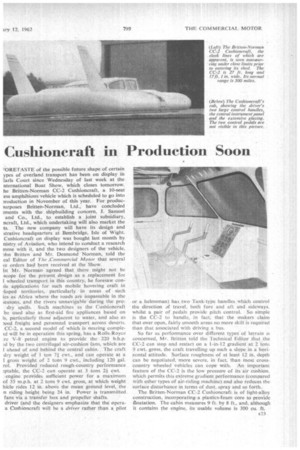Cushioncraft in Production Soon
Page 79

If you've noticed an error in this article please click here to report it so we can fix it.
70RETASTE of the possible future shape of certain ypes of overland transport has been on display in l'arls Court since Wednesday of last week at the riternationat Boat Show, which closes tomorrow. he Britten-Norman CC-2 Cushioncraft, a 10-seat .ess amphibious vehicle which is scheduled to go into 3roduction in November of this year. For produc)urposes Britten-Norman, Ltd., have concluded .7,ments with the shipbuilding concern, J. Samuel and Co., Ltd., to establish a joint subsidiary, ncraft, Ltd., which undertaking will also market the ts. The new company will have its design and strative headquarters at Bembridge, Isle of Wight. Cushioncraft on display was bought last month by nistry of Aviation, who intend to conduct a research mrne with it, and the two designers of the vehicle, 3hn Britten and Mr. Desmond Norman, told the cal Editor of The .Commercial Motor that several ye orders had been received at the Show, 1st Mr. Norman agreed that there might not be scope for the present design as a replacement for 1 wheeled transport in this country, he foresaw con1e applications for such mobile hovering craft in ;loped territories, particularly in areas of such ies as Africa where the roads are impassable in the ieasons, and the rivers unnavigable during the prodry spells. Such machines as the Cushioncraft be used also as first-aid fire appliances based on Is, particularly those adjacent to water, and also as )eed freight and personnel transport across deserts. CC-2, a second model of which is nearing compleid will be in operation this spring, has a Rolls-Royce :re V-8 petrol engine to provide the 220 b.h.p. ;(1 by the two centrifugal air-cushion fans, which are 1 ahead of and behind the central cabin. The craft dry weight of 1 ton 71 cwt., and can operate at a 1 gross weight of 2 tons 9 cwt., including 120 gal. rot. Provided reduced rough-country performance ;ptable, the CC-2 can operate at 3 tons 21 cwt. engine provides sufficient power for a maximum of 55 m.p.h. at 2 tons 9 cwt. gross, at which weight hicle rides 12 in. above the mean ground level, the n riding height being 24 in. Power is transmitted fans via a transfer box and propeller shafts.
driver (and the designers emphasize that the operaa Cushioncraft will be a driver rather than a pilot or a helmsman) ha. two Tank-type handles .which control the direction ,A travel, both fore and aft and sideways. whilst a pair of pedals provide pitch control. So simple is the CC-2 to handle, in fact, that the makers claim that over open, fairly smooth areas no more skill is required than that associated with driving a bus.
So far as performance over different types of 'terrain is concerned, Mr. Britten told the Technical Editor that the CC-,2 can stop and restart on a 1-in-12 gradient at 2 tons 9 cwt. gross, the craft travelling up such a slope in a horizontal attitude. Surface roughness of at least 12 in. depth can be negotiated, more severe, in fact, than most crosscountry wheeled vehicles can cope with. An important feature of the CC-2 is the low pressure of its air cushion, which permits this extreme gradient performance (compared with other types of air-riding machine) and also reduces the surface disturbance in terms of dust, spray and so forth.
The Britten-Norman CC-2 Cushioncraft is of light-alloy construction, incorporating a plastics-foam core to provide floatation. The cabin measures 9 ft. by 8 ft., and, although it contains the engine, its usable volume is 300 Cu. ft.








































































































































